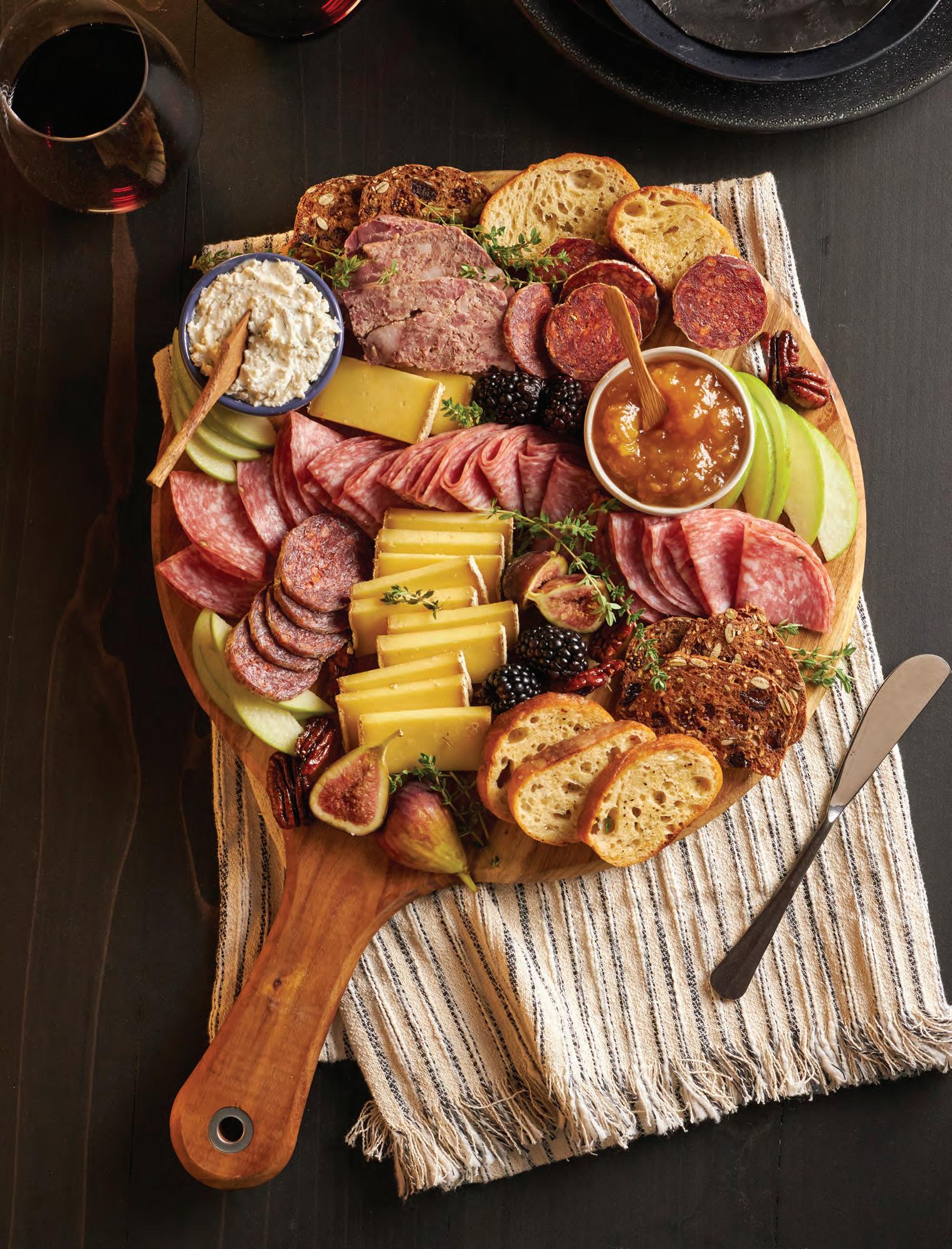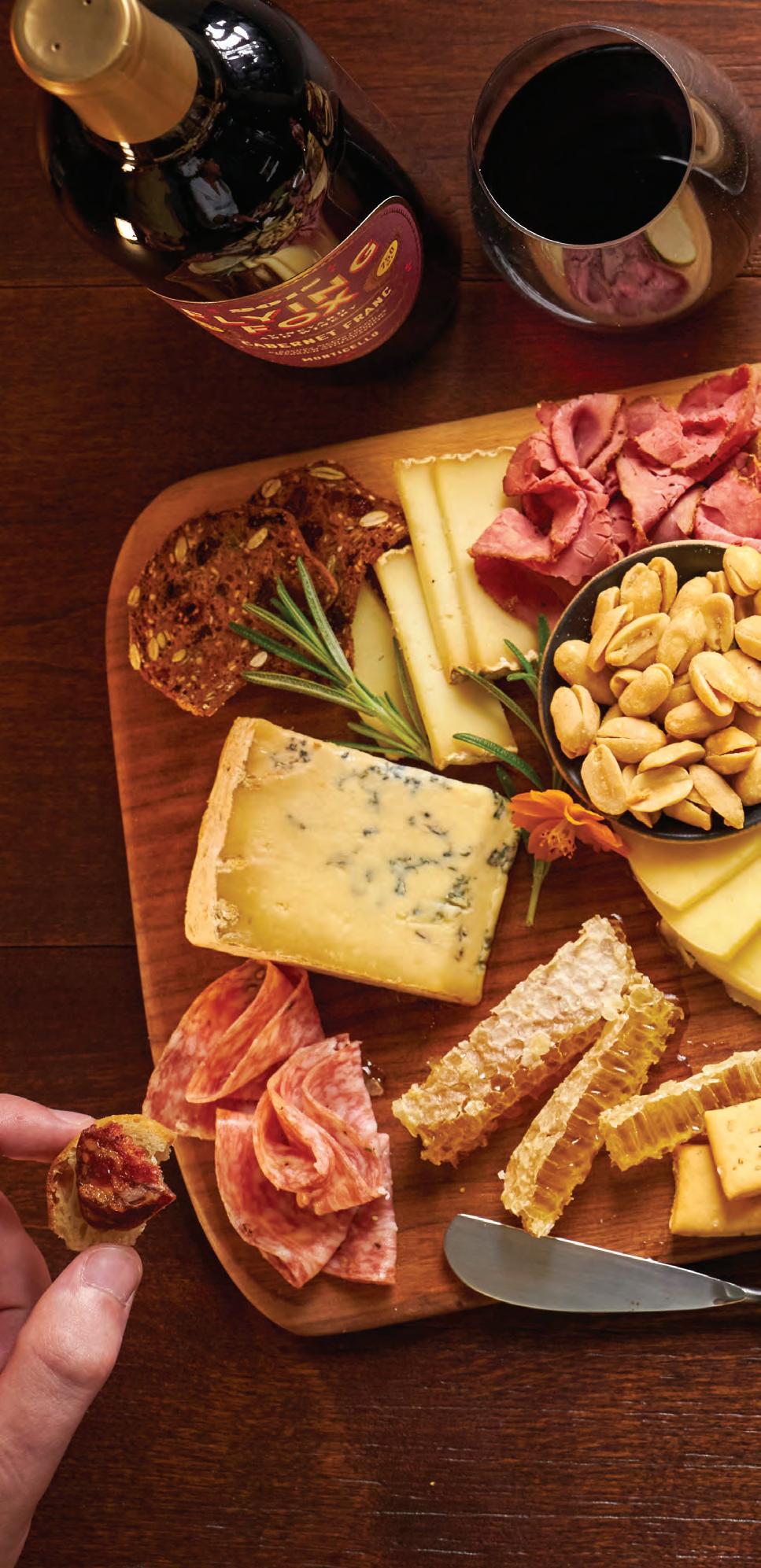
5 minute read
COOKING
“It hit quick,” says Emmie Lewis, owner of RVA Cheese Girl, of the recent charcuterie craze. Lewis offers large-scale graze tables, tasting boards, and individual charcuterie cones, pictured here.
Party on a Platter
Advertisement
Charcuterie boards are shareable, infinitely adaptable, and camera-ready.
By PHAEDRA HISE | Photography by TYLER DARDEN Styling by DEBI SHAWCROSS
The bites we crave when sipping have been elevated to new heights, thanks to the proliferation of kaleidoscopic charcuterie “grazing boards” (remember when they were meat and cheese platters?). These artful arrangements now outpace restaurant #foodporn on social media.
“It hit quick,” says Emmie Lewis, who owns RVA Cheese Girl. “When I started in March of 2020, I was the only one doing this. A year later there were 18 others just in Richmond.” The trend grew out of the spike in stay-at-home socializing in 2020, when home cooks suddenly had plenty of time to create elaborately patterned platters using cured meats, cheeses, fruits, olives, spreads, nuts—and whatever else they had on hand.
Now, these “adult Lunchables”—as Business Insider dubbed them—have spawned a subset of charcuterie (pronounced “shar-ku-tuh-ree”) purveyors: There are caterers, like The Cornichon in Ashburn, and wedding specialists like The Honey Brie in Virginia Beach. Restaurants like Grisette, in Richmond, are built on a charcuterieand-cheese concept. Small shops like Long Board Charcuterie in Virginia Beach sell not just premade boards and ingredients, but picnic accessories. There are even food trucks, like Graze Charcuterie in Hampton and Kass and Cure Board Co. in Charlottesville, which make the rounds from wineries to local festivals and backyard events.
Hosts can buy ingredients and create a board, purchase one ready-made, or order one online from companies like Boundless Boards in Wytheville. Partying solo? Lewis, of RVA Cheese Girl, makes single-serving charcuterie “cones.”
Today, grazing boards are a low-stress way to entertain. The food can be prepared in advance and keeps perfectly at room temperature. Hosts can even order individual tasting boards if guests don’t want to share. And, of course, everyone takes pictures. It’s this visual “wow” factor that’s driven their popularity: “The generation that grew up on social media is now of hosting age,” says Katie Huger, who owns Long Board.
None of this is new, of course. In 15th-century France, local charcutiers produced a range of dried, salted, or cooked meats, rillettes, and pâtés, which varied by region. Italians, too, contributed a spectacular assortment of cured meats—prosciutto, pancetta, and soppressata—both pairing them with the world’s best wines.
A successful charcuterie board is a work of art, says Huger. “If you really want it to be beautiful, practice,” she advises. “The more you do it, the better you’re going to get.”
Here, we offer a paint-by-numbers guide to building a gorgeous charcuterie board with a tempting mix of ingredients that invites guests to mix and match, creating new flavors with every bite.
1. Sketch in the underlying structure
Start with one to three cured meats and one to three cheeses in a mix of flavors, textures, shapes, and sizes. For example, the silkiness of mild prosciutto contrasts well with spicy dry-aged salami, or large slices of pale capicola with small circles of dark red pepperoni.
For cheeses, a soft brie works well with a firm aged gouda or stout wedge of aged parmesan. Selecting a mix of goat, cow, and sheep’s milk cheese also builds in flavor variety.
Arrange these in lines or groups on the board in a balanced format, leaving gaps. In general, slice the meats and harder cheeses, leaving softer cheeses intact, and experiment with folding or rolling larger slices of meat.
The visual “wow” factor has driven the popularity of charcuterie boards.
PRO TIP: TAKE PHOTOS AS YOU GO TO GET A CLEARER PERSPECTIVE OF THE ARRANGEMENT.
2. Fill the outline with color and texture
Dab in dots and blocks of color. Citrus segments, berries, figs, grapes, dried apricots, olives, shelled pistachios, and pickled vegetables all introduce fresh colors, flavors, and textures. Slice or cut ingredients into bite-sized servings and cut grape stems to create small bunches.
Splash on mustards, preserves, or honeycomb— firm condiments directly on the board, runny ones nestled into small containers. Got a holiday gift jam or chutney buried in the cabinet? Open and add it to the mix.
PRO TIP: AIM TO INCLUDE SOMETHING SWEET, SOMETHING SPICY, AND SOMETHING SOUR.
3. Dot the masterpiece with final highlights
Time to accessorize. Set out a companion plate or basket of crackers and breads (keep the flavors simple so they won’t compete with board ingredients). Add small knives, spreaders, spoons, and picks as needed, and include a waste bowl for
Goats R Us garlic and dill chevre.
Olli Salumeria sopresseta pepperoni and calabrese.
Meadow Creek Dairy Appalachian cow’s milk cheese. Stock Provisions paté de campagne.

The Virginia Chutney Company mango chutney.
pits, stems, rinds, and peels.
If desired, top cheeses with edible flower petals like marigolds, nasturtium, or violets. You can also add a few herb sprigs like dill, fennel, basil, rosemary, or chives. Serve with a stack of small plates, if desired, and plenty of napkins!
PRO TIP: PREP ANY EXTRA MEATS AND LEAVE EXTRA CHEESES AT ROOM TEMPERATURE TO REPLENISH THE BOARD AS NEEDED.
When it comes to charcuterie boards, practice makes perfect. Invite friends over to help you develop this new skill—fortunately, any artistic “mistakes” are tasty. Phaedra Hise is the former food editor for Virginia Living and writes frequently about food and restaurants. She lives in Richmond, enthusiastically gardening things that her chef-husband cooks.


THE GRAZE CRAZE
A grazing board is a creative way to showcase Virginia’s deep farming history. Consider featuring a few of these local ingredients at your next gathering, along with a Virginia wine.
Pâté and cured salami from Stock Provisions, CHARLOTTESVILLE StockProvisions.com Cured meats from Olli Salumeria, MECHANICSVILLE Olli.com Appalachian or Grayson cheeses from Meadow Creek Dairy, GALAX MeadowCreekDairy.com Goat cheese from Caromont Farm, ESMONT CaromontCheese.com Aged gouda, cheddar, or Camembert from Locksley Farm, LOUDOUN COUNTY TheAgDistrict.com Plum or mango chutney from the Virginia Chutney Company, FLINT HILL VirginiaChutney.com Honey from Elysium Honey, which manages 175 hives across Virginia. ElysiumHoney.com Salted peanuts from Hubs, SEDLEY HubsPeanuts.com
Olli Salumeria salami. Hubs peanuts.
Mountain Branch Creamery’s Greenfields cheese.
Robin Apiary honey.
Caromont Farms raw goat cheese.
The Whole Ox chorizo. Stock Provisions pastrami and headcheese.















